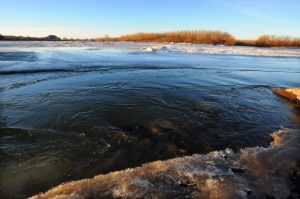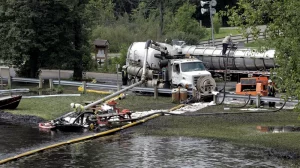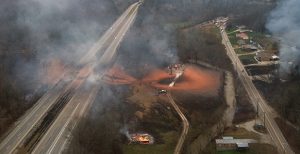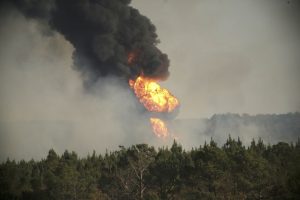Pipelines deliver crude oil and gas to refineries, where they are refined into the items we use on a daily basis. Pipelines transmit these items from there, providing gasoline for our vehicles, trucks, planes, and ships through a huge pipeline infrastructure. Gas is also utilized to heat and prepare food in homes and businesses. These pipelines are found underground and underwater and when unfortunate incidents happen, crude oils and gas spilled cause fire and contamination. Oil is difficult to remove from water, but what happens when it sinks?
Here are the deadliest pipeline accidents within the recent decade.
- Western North Dakota, near Belfield: Dec. 5, 2016
 A leak in the Belle Fourche pipeline was discovered fewer than 150 miles from Oceti Sakowin Camp. An estimated 176,000 gallons of oil spilled, and crews are exploring whether they can burn some of the spilled oil to prevent future spread. Less than a third of the oil had been recovered 10 days after the spill was detected. However, this isn’t the first time True Companies, the pipeline operator, has made headlines.
A leak in the Belle Fourche pipeline was discovered fewer than 150 miles from Oceti Sakowin Camp. An estimated 176,000 gallons of oil spilled, and crews are exploring whether they can burn some of the spilled oil to prevent future spread. Less than a third of the oil had been recovered 10 days after the spill was detected. However, this isn’t the first time True Companies, the pipeline operator, has made headlines.
- Yellowstone River, northeastern Wyoming: Jan. 17, 2015
 The Poplar oil line, operated by True Company/Bridger Pipeline, spilled 32,000 gallons of oil into the Yellowstone River, a tributary of the Missouri River (and by extension, upstream of Standing Rock). The pipeline was meant to be buried eight feet into the riverbed, but investigators discovered that it was entirely exposed after the spill. It wouldn’t be the first time the Yellowstone River had done so. When an Exxon pipeline got exposed and was broken by flood debris in July 2013, it spilled 63,000 gallons of oil directly into a different stretch of the river.
The Poplar oil line, operated by True Company/Bridger Pipeline, spilled 32,000 gallons of oil into the Yellowstone River, a tributary of the Missouri River (and by extension, upstream of Standing Rock). The pipeline was meant to be buried eight feet into the riverbed, but investigators discovered that it was entirely exposed after the spill. It wouldn’t be the first time the Yellowstone River had done so. When an Exxon pipeline got exposed and was broken by flood debris in July 2013, it spilled 63,000 gallons of oil directly into a different stretch of the river.
- Kalamazoo River, Michigan: July 25, 2010
 A thirty-inch pipeline carrying diluted bitumen from Canada burst a six-foot gash along a deteriorated seam in south-central Michigan, spilling 843,000 gallons of heavy oil product into the Kalamazoo River. The pipeline’s operator, Canadian energy transporter Enbridge, would be held accountable for the greatest inland oil leak in U.S. history, with the U.S. A member of the National Transportation Safety Board likened the company’s spill response to the “Keystone Cops.” The Enbridge oil spill rapidly became Exhibit A in the argument against the Keystone XL pipeline, which President Obama finally rejected in 2015. While scientists and activists discussed whether or not diluted tar sands bitumen was more destructive to pipelines than ordinary oil, another significant tar sands pipeline made the news.
A thirty-inch pipeline carrying diluted bitumen from Canada burst a six-foot gash along a deteriorated seam in south-central Michigan, spilling 843,000 gallons of heavy oil product into the Kalamazoo River. The pipeline’s operator, Canadian energy transporter Enbridge, would be held accountable for the greatest inland oil leak in U.S. history, with the U.S. A member of the National Transportation Safety Board likened the company’s spill response to the “Keystone Cops.” The Enbridge oil spill rapidly became Exhibit A in the argument against the Keystone XL pipeline, which President Obama finally rejected in 2015. While scientists and activists discussed whether or not diluted tar sands bitumen was more destructive to pipelines than ordinary oil, another significant tar sands pipeline made the news.
- Mayflower, Arkansas: March 29, 2013
 Exxon Mobil’s Pegasus pipeline ruptured in a peaceful Arkansas suburb, pouring an estimated 210,000 gallons of tar sands bitumen through a residential community and into Lake Conway. We used satellite imagery collected before and after the disaster, with the help of the Arkansas Chapter of the Sierra Club, to document the impact on the community and neighboring public areas.
Exxon Mobil’s Pegasus pipeline ruptured in a peaceful Arkansas suburb, pouring an estimated 210,000 gallons of tar sands bitumen through a residential community and into Lake Conway. We used satellite imagery collected before and after the disaster, with the help of the Arkansas Chapter of the Sierra Club, to document the impact on the community and neighboring public areas.
- Burnaby, British Columbia: July 24, 2007
 A contractor’s backhoe struck the Transmountain Pipeline in Westridge on a hot summer afternoon in British Columbia, releasing a gusher of more than 59,000 gallons of crude oil into a residential neighborhood. However, in 2016, Canadian Prime Minister Justin Trudeau accepted Kinder Morgan’s plans to build the Transmountain Pipeline while opposing Enbridge’s Northern Gateway pipeline. Locals are concerned about the potential of oil spills from increased oil tanker traffic along the beaches, in addition to incidents on land. When the Nathan E. Stewart, a tug boat, ran aground at Bella Bella, BC while pushing an empty fuel barge, those fears were reignited. Even though there was no cargo on the barge, the tug’s fuel and hydraulic fluids contaminated the beach and shellfish beds, and it took over a month to get the Stewart out of the water. Although these incidents have all involved oil pipelines, natural gas and refined petroleum pipelines also pose a concern.
A contractor’s backhoe struck the Transmountain Pipeline in Westridge on a hot summer afternoon in British Columbia, releasing a gusher of more than 59,000 gallons of crude oil into a residential neighborhood. However, in 2016, Canadian Prime Minister Justin Trudeau accepted Kinder Morgan’s plans to build the Transmountain Pipeline while opposing Enbridge’s Northern Gateway pipeline. Locals are concerned about the potential of oil spills from increased oil tanker traffic along the beaches, in addition to incidents on land. When the Nathan E. Stewart, a tug boat, ran aground at Bella Bella, BC while pushing an empty fuel barge, those fears were reignited. Even though there was no cargo on the barge, the tug’s fuel and hydraulic fluids contaminated the beach and shellfish beds, and it took over a month to get the Stewart out of the water. Although these incidents have all involved oil pipelines, natural gas and refined petroleum pipelines also pose a concern.
- Sissonville, West Virginia: Dec. 11, 2012
 An aged 20-inch transmission line built in the 1960s erupted in the Mountain State, engulfing Interstate 77 in flames and damaging several homes. There were no fatalities, thankfully.
An aged 20-inch transmission line built in the 1960s erupted in the Mountain State, engulfing Interstate 77 in flames and damaging several homes. There were no fatalities, thankfully.
- Salem Township, Pennsylvania: April 29, 2016
 A thirty-inch gas transmission pipe exploded in western Pennsylvania recently, damaging a house and putting a 26-year-old man in the hospital with third-degree burns covering more than 75 percent of his body. According to the order issued by PHMSA, pipeline personnel at the Delmont compressor station first heard the explosion and immediately began shutting down the line. The incident was reported to the National Response Center about an hour later by Spectra staff. The incident took place in a right-of-way with four pipes, one of which was out of service at the time. As part of the order, all four lines will be turned off. The blast created a 12 foot deep, 1500 square foot hole in the ground, scorching 40 acres. 100 feet away, a 24.5-foot portion of 30-inch diameter pipe landed. According to the PHMSA, an undetermined volume of natural gas was spilled into the sky. The EPA also claims that the explosion had no effect on Beaver Run Creek, a local watercourse.
A thirty-inch gas transmission pipe exploded in western Pennsylvania recently, damaging a house and putting a 26-year-old man in the hospital with third-degree burns covering more than 75 percent of his body. According to the order issued by PHMSA, pipeline personnel at the Delmont compressor station first heard the explosion and immediately began shutting down the line. The incident was reported to the National Response Center about an hour later by Spectra staff. The incident took place in a right-of-way with four pipes, one of which was out of service at the time. As part of the order, all four lines will be turned off. The blast created a 12 foot deep, 1500 square foot hole in the ground, scorching 40 acres. 100 feet away, a 24.5-foot portion of 30-inch diameter pipe landed. According to the PHMSA, an undetermined volume of natural gas was spilled into the sky. The EPA also claims that the explosion had no effect on Beaver Run Creek, a local watercourse.
- Shelby County, Alabama: Oct. 31, 2016
 An excavator working on the Colonial Pipeline to fix a previous incident collided with the enormous gasoline transmission line, creating a fiery explosion and killing two people. The Colonial Pipeline, which is the largest petroleum distribution system in the United States, supplies 40% of the gasoline consumed on the East Coast. As we’ve previously reported, even the Obama Administration has failed to address severe pipeline safety concerns. Despite assertions that contemporary pipelines will be secure and equipped with spill-prevention equipment, we have yet to see proof that this technology has prevented large accidents. Shell recently lost 90,000 gallons of oil from a subsea pipeline in the Gulf of Mexico, but it was a helicopter pilot who happened to be passing by who was credited with detecting it, not the pipeline operator.
An excavator working on the Colonial Pipeline to fix a previous incident collided with the enormous gasoline transmission line, creating a fiery explosion and killing two people. The Colonial Pipeline, which is the largest petroleum distribution system in the United States, supplies 40% of the gasoline consumed on the East Coast. As we’ve previously reported, even the Obama Administration has failed to address severe pipeline safety concerns. Despite assertions that contemporary pipelines will be secure and equipped with spill-prevention equipment, we have yet to see proof that this technology has prevented large accidents. Shell recently lost 90,000 gallons of oil from a subsea pipeline in the Gulf of Mexico, but it was a helicopter pilot who happened to be passing by who was credited with detecting it, not the pipeline operator.
Even if we could put an end to this string of disasters, many people oppose pipelines since each new project represents a multi-million dollar commitment to continue fossil fuel extraction and use for decades.



